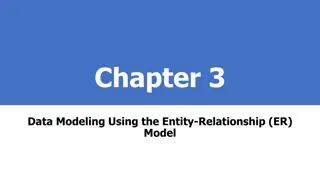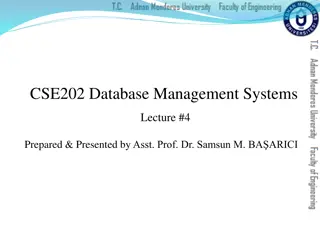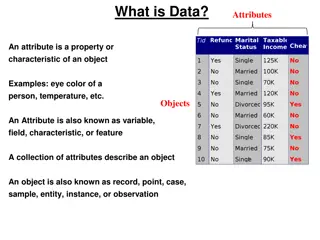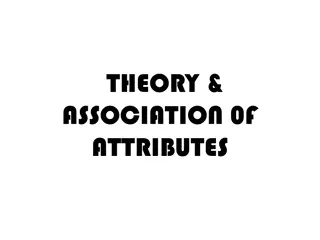Understanding Modeling Entities and Attributes in Database Systems
Entities, relationships, and attributes are fundamental constructs in the Entity-Relationship (E-R) model. Entities represent people, places, objects, events, or concepts in a user environment. Each entity type has a set of attributes defining its properties. It is crucial to distinguish between entity types and instances, as well as follow specific guidelines for naming and defining entity types.
Download Presentation

Please find below an Image/Link to download the presentation.
The content on the website is provided AS IS for your information and personal use only. It may not be sold, licensed, or shared on other websites without obtaining consent from the author. Download presentation by click this link. If you encounter any issues during the download, it is possible that the publisher has removed the file from their server.
E N D
Presentation Transcript
Database System Instructor: Sadiq Shah (Lecture 04)
Entities The basic constructs of the E-R model are entities, relationships, and attributes. Entities An entity is a person, a place, an object, an event, or a concept in the user environment about which the organization wishes to maintain data. Thus, an entity has a noun name. Some examples of each of these kinds of entities follow: Person: EMPLOYEE, STUDENT, PATIENT Place: STORE, WAREHOUSE, STATE Object: MACHINE, BUILDING, AUTOMOBILE Event: SALE, REGISTRATION, RENEWAL Concept: ACCOUNT, COURSE, WORK CENTER
ENTITY TYPE VERSUS ENTITY INSTANCE Entity type There is an important distinction between entity types and entity instances. An entity type is a collection of entities that share common properties or characteristics. Each entity type in an E-R model is given a name. Because the name represents a collection (or set) of items, it is always singular. An entity instance is a single occurrence of an entity type. Figure illustrates the distinction between an entity type and two of its instances. An entity type is described just once (using metadata) in a database, whereas many instances of that entity type may be represented by data stored in the database
NAMING AND DEFINING ENTITY TYPES There are a few special guidelines for naming entity types, which follow: a) 1. An entity type name is a singular noun (such as CUSTOMER, STUDENT, or AUTOMOBILE); b) 2. An entity type name should be specific to the organization. Thus, one organization may use the entity type name CUSTOMER, and another organization may use the entity type name CLIENT c) 3. An entity type name should be concise, using as few words as possible. E.g REGISTRATION instead of STUDENT REGISTRATION FOR CLASS
NAMING AND DEFINING ENTITY TYPES d) An abbreviation, or a short name, should be specified for each entity type name, and the abbreviation may be sufficient to use in the E-R diagram. e) The name used for the same entity type should be the same on all E-R diagrams on which the entity type appears. Thus, as well as being specific to the organization, the name used for an entity type should be a standard, adopted by the organization for all references to the same kind of data.
Attributes Each entity type has a set of attributes associated with it. An attribute is a property or characteristic of an entity type that is of interest to the organization. An attribute has a noun name. Following are some typical entity types and their associated attributes: STUDENT Student ID, Student Name, Home Address, Phone Number, Major AUTOMOBILE Vehicle ID, Color, Weight, Horsepower EMPLOYEE Employee ID, Employee Name, Payroll Address, Skill
Types of Attributes REQUIRED VERSUS OPTIONAL ATTRIBUTES: SIMPLE VERSUS COMPOSITE ATTRIBUTES SINGLE-VALUED VERSUS MULTIVALUED ATTRIBUTES STORED VERSUS DERIVED ATTRIBUTES IDENTIFIER ATTRIBUTE
Types of Attributes-I REQUIRED VERSUS OPTIONAL ATTRIBUTES An attribute that must be present for each entity instance is called a required attribute, whereas an attribute that may not have a value is called an optional attribute.
Types of Attributes-II SIMPLE VERSUS COMPOSITE ATTRIBUTES An attribute that cannot be broken down into smaller components that are meaningful to the organization is simple attribute. While composite attributes are those that has meaningful component parts (attributes). Address, which can usually be broken down into the following component attributes: Street Address, City, State, and Postal Code. A simple (or atomic) attribute is an attribute that cannot be broken down into smaller components that are meaningful for the organization. For example, all the attributes associated with AUTOMOBILE are simple: Vehicle ID, Color, Weight, and Horsepower.
Types of Attributes-III SIMPLE VERSUS COMPOSITE ATTRIBUTES
Types of Attributes-IV SINGLE-VALUED VERSUS MULTIVALUED ATTRIBUTES Single Valued attribute: An attribute that may take only one value for a given entity (or relationship) instance. Multivalued attribute: An attribute that may take on more than one value for a given entity (or relationship) instance. In this text, we indicate a multivalued attribute with curly brackets around the attribute name, as shown for the Skill attribute in the EMPLOYEE example
Types of Attributes-V MULTIVALUED ATTRIBUTES
Types of Attributes-VI STORED VERSUS DERIVED ATTRIBUTES Derived attribute: An attribute whose values can be calculated from related attribute values that are stored in the database. For example, the EMPLOYEE entity type has a Date Employed attribute. If users need to know how many years a person has been employed, that value can be calculated using Date Employed and today s date. We indicate a derived attribute in an E-R diagram by using square brackets around the attribute name.
Types of Attributes-VII IDENTIFIER ATTRIBUTE An identifier is an attribute (or combination of attributes) whose value distinguishes individual instances of an entity type. That is, no two instances of the entity type may have the same value for the identifier attribute. The identifier for the STUDENT entity type introduced earlier is Student ID, whereas the identifier for AUTOMOBILE is Vehicle ID. Notice that an attribute such as Student Name is not a candidate identifier, because many students may potentially have the same name We underline identifier names on the E-R diagram
Types of Attributes-VIII IDENTIFIER ATTRIBUTE























